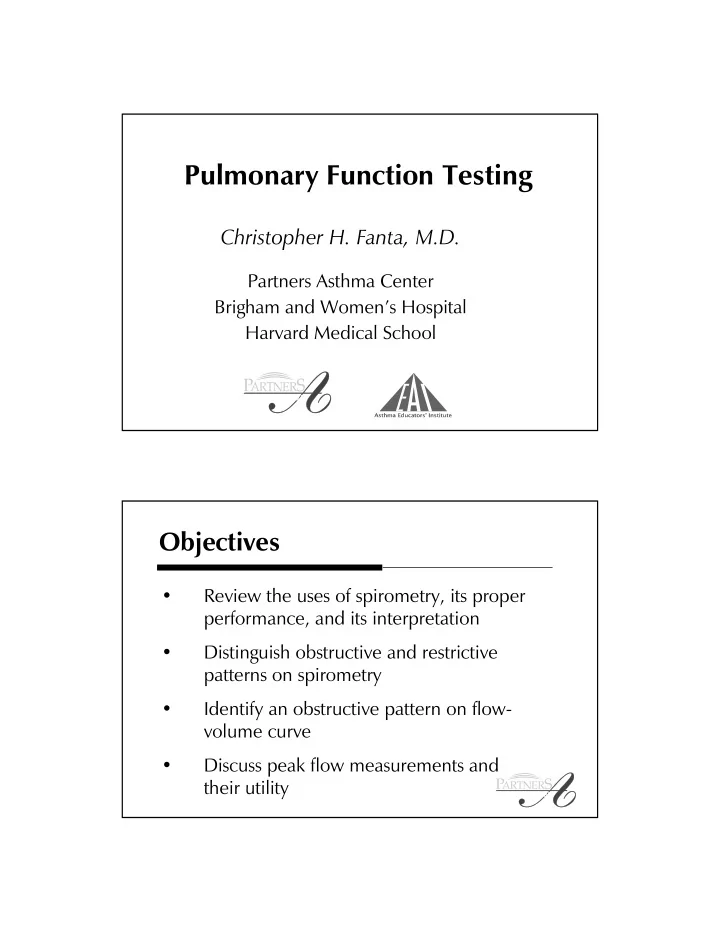

Pulmonary Function Testing Christopher H. Fanta, M.D. Partners Asthma Center Brigham and Women’s Hospital Harvard Medical School Objectives • Review the uses of spirometry, its proper performance, and its interpretation • Distinguish obstructive and restrictive patterns on spirometry • Identify an obstructive pattern on flow- volume curve • Discuss peak flow measurements and their utility
Role of Spirometry • Distinguish normal vs abnormal • Distinguish obstructive vs. restrictive pattern (or both) • Assess severity of the abnormality • In obstructive abnormalities, assess for reversibility of the obstruction • Monitor for changes over time Spirograph
Technically Poor Tracing: Second Breath In
Technically Poor Tracing: Incomplete Exhalation (<6 sec.) FVC
FEV 1 FEV 1 /FVC FVC FEV 1
FEF 25-75 PEFR V MAX 50 V MAX 75
My Numeric Spirometry Results • FVC = 5.70 L • FEV 1 = 4.45 L • FEV 1 /FVC = 0.78 • FEF 25-75 = 3.99 L/sec Defining Normal Values • Average normal predicted values are based on age, height, and gender • There are racial differences in average normal values • Defining normal ranges around the predicted average
Defining the Normal Range of Values Normal ranges around the predicted average: • Most widely used method: • FEV 1 and FVC >80% (100% + 20%) • FEV 1 /FVC >95% • 95% confidence intervals (> lower limit of normal) Normal Spirometry Spirometry (BTPS) Predicted Range Actual % Pred Mean 95% CI FVC (Lts) 5.70 109 5.19 4.14 FEV 1 (Lts) 4.45 105 4.22 3.35 FEV 1 /FVC (%) 78 98 79 71 FEF 25-75 (L/s) 3.99 93 4.29 PEFR (L/s) 9.98 105 9.48 FET (Secs) 16.81
Normal Spirometry Spirometry (BTPS) Predicted Range Actual % Pred Mean 95% CI FVC (Lts) 5.70 109 5.19 4.14 FEV 1 (Lts) 4.45 105 4.22 3.35 FEV 1 /FVC (%) 78 98 79 71 FEF 25-75 (L/s) 3.99 93 4.29 PEFR (L/s) 9.98 105 9.48 FET (Secs) 16.81 Spirometry in Obstructive Defect FVC Volume (Liters) FEV 1 2 0 2 4 6 8 10 Time (Secs)
Moderate Obstructive Defect Spirometry (BTPS) Predicted Range Actual % Pred Mean 95% CI FVC (Lts) 2.53 100 2.51 1.7 FEV 1 (Lts) 1.31 63 2.05 1.41 FEV 1 /FVC (%) 51 63 80 71 FEF 25-75 (L/s) 0.55 25 2.16 PEFR (L/s) 3.67 75 4.85 FET (Secs) 11.67 Definition of Obstructive Abnormality • Reduced FEV 1 /FVC obstructive defect • Normal or increased FEV 1 /FVC no obstruction
Flow-Volume Curve in Obstructive Abnormality Bronchodilator Response Significant improvement: • 12% increase in FEV 1 , and • 200 cc increase in FEV 1
Significant Bronchodilator Response Moderate Restrictive Defect Spirometry (BTPS) Predicted Range Actual % Pred Mean 95% CI FVC (Lts) 3.82 64 5.88 4.83 FEV 1 (Lts) 3.36 69 4.85 3.99 FEV 1 /FVC (%) 88 108 81 73 FEF 25-75 (L/s) 4.6 91 5.02 PEFR (L/s) 9.43 91 10.28 FET (Secs) 6.15
Spirometry and Flow-Volume Curve in Restrictive Defect 2 3 4 1 -2 Volume (Liters) Spirometry and Flow-Volume Curve In Severe Obstruction Volume-Time Flow-Volume FVC 3 3 FEV 1 2 FEF 50 2 1 1 0 1 2 3 4 5 6 7 8 0 1 2
Severe Obstructive Defect Spirometry (BTPS) Predicted Range Pre -bronchodilator Actual % Pred Mean 95% CI FVC (Lts) 1.84 65 2.80 1.98 FEV 1 (Lts) 0.66 28 2.28 1.63 FEV 1 /FVC (%) 36 45 80 71 FEF 25-75 (L/s) 0.26 10 2.39 PEFR (L/s) 2.16 39 5.51 FET (Secs) 7.76 Severe Obstructive Defect Lung Volumes VC VC VC TLC RV Normal Obstructed Restricted
Peak Flow Meters Useful: • To diagnose asthma • to assess asthma severity • when symptoms change • when medications are changed • during an asthma attack Peak Flow Monitoring • Measure 3 times and record the best value • Establish your personal best • For daily monitoring, check your PEFR before your daily medications • Daily monitoring not necessary • Analogy: using a thermometer to quantify the severity of a fever
Conclusions • The key measurements on spirometry are the FVC, FEV 1 , and FEV 1 /FVC. • An obstructive pattern on spirometry is identified by a reduced FEV 1 /FVC and by the scooped appearance of the flow-volume curve. Conclusions (cont.) • A significant bronchodilator response involves a 12% increase in FEV 1 (and at least 200 cc increase in FEV 1 ). • Peak flow measurements cannot distinguish obstructive vs. restrictive abnormalities; but in persons with established obstructive disease, they can be useful to monitor changes in lung function.
Case Example • A 52-year old man presents with a chief complaint of dyspnea on exertion. • He smoked a pack of cigarettes/day for 30 years, quitting five years ago. He has had gradually increasing shortness of breath with exertion over the past six months, to the point of breathlessness on climbing one flight of stairs. He is comfortable at rest, including sleeping on one pillow. Case Example (cont.) • On examination, he is morbidly obese with a normal cardiopulmonary exam. • His chest X-ray is normal.
Question #1 • With the above history and the following pulmonary function test results, which is the most likely diagnosis? Question #4
Question #2 • With the same history and the following pulmonary function test results, which is the most likely diagnosis? Question #4
Question #3 • With the same history and the following pulmonary function test results, which is the most likely diagnosis? Question #4
Case Example A 24 year-old college student without • prior history of allergies or asthma complains of cough and loud wheezing. • You confirm inspiratory and expiratory wheezes on physical exam. • Spirometry/flow-volume results are shown on the next slide. Question #4
Recommend
More recommend